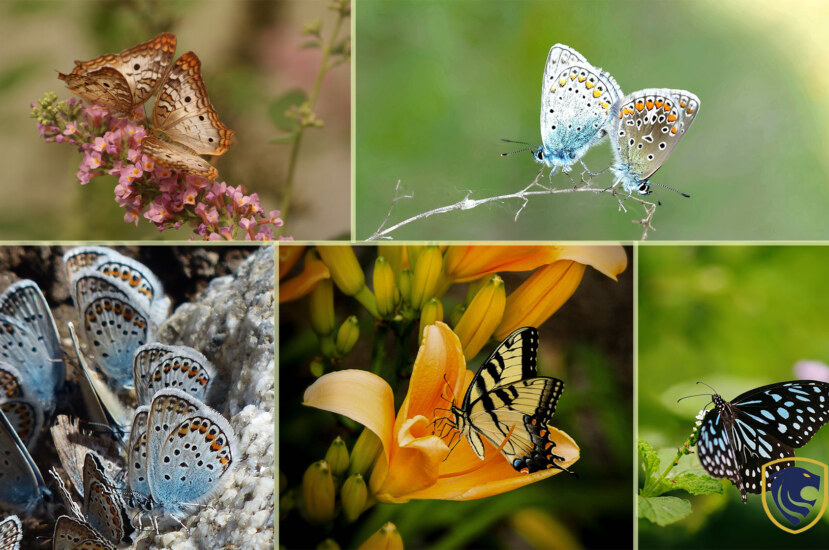This is the second part of the article about the most beautiful butterflies in the world. If you didn’t read the first part of the article, click the link to go to the first article.
Emerald Swallowtail
The Emerald Swallowtail Butterfly, known as Papilio Palinurus, is a captivating species in Southeast Asia. Its beauty lies in its vibrant color combination and elegant wing shape. Moreover, with a wingspan of approximately 3 to 4 inches, the Emerald Swallowtail Butterfly boasts an impressive size.
The wings of the Emerald Swallowtail Butterfly showcase a stunning palette of colors. The upper side of its wings displays a vibrant green shade, reminiscent of precious emeralds. The green coloration is accentuated by intricate black markings and patterns, adding depth and definition to its appearance. The undersides of its wings feature a more subdued hue with mottled brown and green tones, serving as camouflage when the butterfly rests on foliage.

Emerald Swallowtail
What sets the Emerald Swallowtail Butterfly apart is the distinct swallowtail shape of its hindwings. The elongated projections resembling the tails of swallows give the butterfly its name and contribute to its overall elegance. The tails are adorned with intricate black and blue patterns, enhancing the butterfly’s visual appeal.
The Emerald Swallowtail Butterfly’s Flight is a spectacle to behold. With graceful and swift movements, it navigates through its natural habitat, adding to its allure. Its slender body and long, slender wings further enhance its beauty, allowing it to glide through the air effortlessly.
The Emerald Swallowtail Butterfly is highly prized by butterfly enthusiasts and collectors for its striking appearance. However, it is essential to appreciate these stunning creatures in their natural environments and support conservation efforts. Preserving the diverse ecosystems of Southeast Asia is crucial for the continued existence of the Emerald Swallowtail Butterfly, ensuring that future generations can witness the beauty and grace of this remarkable species.
Spicebush Swallowtail
The Spicebrush Swallowtails Butterfly, known as Papilio troilus, is a captivating species in North America. Its beauty lies in its unique color combination and intricate patterns. Also, with a 2.5 to 4 inches wingspan, the Spicebush Swallowtails Butterfly is of medium size.
The upper side of its wings features a striking black color with elegant blue or green iridescent patches, adding a touch of brilliance. Furthermore, these shimmering patches can vary in intensity and hue depending on the individual butterfly. The contrast between the dark base color and the vibrant patches creates a captivating display of colors.
The hindwings of the Spicebush Swallowtails Butterfly boast an intricate pattern of yellow or orange spots, arranged in rows or bands. These bright spots stand out against the dark background, further enhancing the butterfly’s beauty. The intricate patterns and colors serve as a form of camouflage, aiding the butterfly in blending with its environment and avoiding predators.

Spicebush Swallowtail
The Spicebrush Swallowtails Butterfly’s flight is a graceful and leisurely spectacle. With slow, deliberate wingbeats, it navigates through its natural habitat, showcasing its beauty in motion. The slender body and long, elegant wings contribute to its overall grace.
The Spicebrush Swallowtails Butterfly is highly regarded for its visual appeal and is sought after by butterfly enthusiasts. However, it is crucial to appreciate these beautiful creatures in their natural habitats and support conservation efforts. Preserving the diverse ecosystems of North America, including the host plants on which the Spicebrush Swallowtails Butterfly relies, is vital for their continued existence.
Queen Alexandra’s Birdwing
Queen Alexandra’s Birdwing Butterfly, scientifically known as Ornithoptera alexandrae, is a breathtaking species found in Papua New Guinea. It is renowned for its immense size, captivating beauty, and vibrant color combination. Also, with a wingspan reaching up to 12 inches, it holds the title of the world’s largest butterfly.
The wings of Queen Alexandra’s Birdwing Butterfly are a masterpiece of nature’s artistry. The upper side of its wings boasts a striking combination of black and iridescent emerald-green scales. Moreover, these vivid green hues, along with intricate black patterns and markings, create a visually stunning display. The contrast between the vibrant green and the black highlights the butterfly’s majestic presence.

Queen Alexandra’s Birdwing
What sets Queen Alexandra’s Birdwing Butterfly apart is the intricate design on its hindwings. These wings feature an array of red, yellow, and cream-colored spots, arranged in an eye-catching pattern. Also, these spots contribute to the overall grandeur and elegance of the butterfly, adding depth and complexity to its appearance.
The beauty of Queen Alexandra’s Birdwing Butterfly is further enhanced by its graceful flight. With slow and deliberate wingbeats, it glides through the rainforests of Papua New Guinea, capturing the attention of all who witness its majestic presence. It’s large size and prominent colors make it a true spectacle in flight.
Due to its extraordinary beauty, Queen Alexandra’s Birdwing Butterfly has unfortunately faced significant threats from habitat loss and over-collecting. Conservation efforts are crucial to protect its fragile rainforest habitat and ensure its survival for future generations to appreciate. Preserving the biodiversity-rich areas of Papua New Guinea is vital not only for the survival of Queen Alexandra’s Birdwing Butterfly but also for the countless other species that call these rainforests home.
Crowned Hairstreak
The Crowned Hairstreak Butterfly, scientifically known as Evenus coronata, is a captivating species found in Central and South America. Its beauty lies in its intricate patterns and unique color combination. With a wingspan of approximately 1.5 to 2 inches, the Crowned Hairstreak Butterfly is relatively small.
The upper side of its wings is adorned with a striking combination of dark brown and metallic blue. The blue coloration shimmers in the light, adding a touch of brilliance to the butterfly’s appearance. Delicate black lines and markings accentuate the overall pattern, creating a visually captivating display.
What sets the Crowned Hairstreak Butterfly apart is the elaborate pattern on the undersides of its wings. The wings showcase a mosaic of intricate designs, with a combination of dark brown, orange, and cream-colored patches. These patches blend harmoniously, creating a stunning and eye-catching display. The undersides of the wings also feature a row of small, white “crown” markings, giving the butterfly its name.

Crowned Hairstreak
The flight of the Crowned Hairstreak Butterfly is delicate. With swift and agile movements, it flutters through the forest understory, captivating observers with its elegance. It’s slender body and intricate wing patterns contribute to its overall charm and beauty.
The Crowned Hairstreak Butterfly’s habitat primarily consists of forested areas and woodland edges. Conservation efforts to protect its natural habitats are crucial for the preservation of this remarkable species.
The Crowned Hairstreak Butterfly serves as a reminder of the astonishing diversity found in the natural world. It’s intricate patterns and unique color combination are a testament to the wonders of nature. Also, they inspire us to cherish and protect the delicate balance of ecosystems where these butterflies thrive.
The Amber Phantom Butterflies
The Amber Phantom Butterflies, scientifically known as Haetera piera, is a captivating species found in Central and South America. Its beauty lies in its enchanting color combination and ethereal appearance. With a wingspan of approximately 2 to 2.5 inches, the Amber Phantom Butterfly is medium size.
The wings of the Amber Phantom Butterflies showcase a delicate and translucent amber color. Moreover, this unique hue gives the butterfly an ethereal and otherworldly quality, as if it is made of delicate glass. The transparency of its wings allows light to pass through, creating a mesmerizing effect.
The edges of the wings are adorned with subtle black and dark brown markings, adding depth and definition to their appearance. Also, these markings contribute to the intricate patterns that give the Amber Phantom Butterfly its charm and allure. The combination of the amber color and the intricate patterns creates a captivating display of beauty.

The Amber Phantom Butterflies
The flight of the Amber Phantom Butterflies is graceful and unhurried. So, it floats through its natural habitat, captivating observers with its delicate and gentle movements. It’s slender body and slender wings add to its overall elegance and beauty.
The Amber Phantom Butterfly’s habitat primarily consists of forested areas, where it can be found near the forest edges and open clearings. Moreover, conservation efforts to protect its natural habitats are crucial for the preservation of this remarkable species. By preserving these ecosystems, we ensure that future generations can marvel at the beauty and ethereal presence of the Amber Phantom Butterfly.
Teinopalpus aureus
The Teinopalpus aureus Butterfly, also known as the Golden Kaiser-i-Hind, is a striking species found in the Himalayan regions of India, Nepal, and Bhutan. Its beauty lies in its vibrant color combination and regal appearance. With a wingspan of approximately 3 to 4 inches, the Teinopalpus aureus Butterfly is of medium to large size.
The upper side of its wings is a dazzling combination of metallic green and gold. The green coloration shimmers in the sunlight, giving the butterfly an iridescent and regal glow. Delicate black veins traverse the wings, accentuating the overall pattern and adding definition.

Teinopalpus aureus
What sets the Teinopalpus aureus Butterfly apart is the stunning contrast between the metallic green and the rich, golden bands that adorn the outer edges of its wings. Moreover, these bands give the butterfly a majestic and regal appearance, as if it is adorned with royal jewelry. Also, the intricate patterns and colors create a captivating and breathtaking display of beauty.
The flight of the Teinopalpus aureus Butterflies is elegant and leisurely. With slow and deliberate wingbeats, it gracefully glides through its mountainous habitat, enchanting observers with its majestic presence. Also, its slender body and long, slender wings contribute to its overall grace and beauty.


